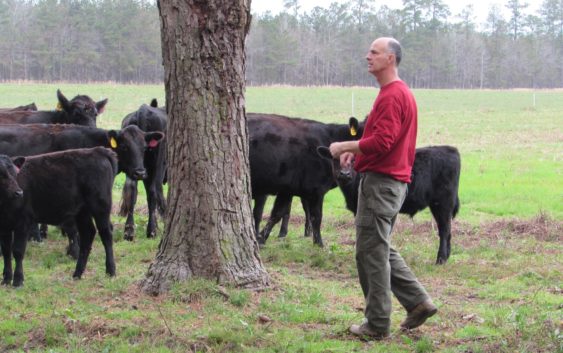- Governor Cooper to reveal crucial disaster recovery plan for Hurricane Helene relief Wednesday
- Active-duty military winding down Hurricane Helene recovery mission in western North Carolina
- Right-wing political activists call for NC lawmakers to decide 2024 presidential election results after Hurricane Helene's impact
- Grove Park Inn cancels National Gingerbread House Competition for 2024 due to Hurricane Helene devastation
- Trump makes more debunked claims about FEMA as he surveys storm damage in North Carolina
Pender farmers still struggling after Florence

Hurricane’s floodwaters left pastures ruined, feed for livestock hard to find
PENDER COUNTY — The floods that drenched Pender County cattleman Buron Lanier’s pastures have long receded, but there is little use in turning his 150 cows and their calves out to enjoy them. There is barely a blade left of the cool-season grasses meant to support his herd through the winter. Four feet of water sitting on the ground for weeks at a time is apparently not a recipe for horticultural success.
The storm is over, but the heartache continues, Lanier said as he walked around one of his farms on Piney Woods Road near Burgaw in late February. The pasture is gone, as are many of the fences and about 300 mature trees. A group of Illinois volunteers from Fellowship of Christian Farmers International were on the farm this week helping with the fences and trees, and Lanier is gearing up for major pasture renovations that will employ some of the lessons learned from Florence’s visit.
Bahiagrass, which a pre-Florence Lanier categorized as something closer to a weed than a feed, was just about the only grass that survived weeks underwater, and “if the good Lord is telling you something, you should listen,” Lanier said. He will begin planting about 100 acres of bahiagrass in early spring, and the forage — palatable if not abundantly nutritious — will assume a larger role in his post-storm grazing scheme.
Perennial cool-season grasses, like fescue, will still be dominant on the farm. Those grasses are strongest during the time of the year when young stock is growing and putting on weight. Warm-season grasses will play a role, and annual grasses fill in the gaps, Lanier explained.
“Each grass has its own little niche,” he said.
Two-year rebuilding process
If he had more pasture diversity when Florence hit, Lanier said, the farm would be in far better shape now. He might be faced with renovating 10 percent of his fields instead of the 90 percent overhaul he is currently facing. Under a new management philosophy, his grazing will be about a third bahiagrass, a third summer and fall annuals, and a third cool-season fescue, Lanier said.
He estimates rebuilding his pastures to be a roughly two-year process. That involves not only the planting and the careful nurture that young plants require in order to properly establish, but also selling off about half his herd, keeping only what the compromised fields will support. Longer term, Lanier said he will rebuild the herd from the core of top-producing cows that he is retaining.
He is not the only local cattleman selling, however, and the explosion of cull cows on the market drove down the auction price by about 50 percent right after the storm, Lanier said.
For local cattlemen, that was insult added to injury.
‘It’s time to start planting’
There are bright spots amid all the dark, however. A Farm Bureau/Extension/N.C. Cattlemen’s Association hay-relief effort helped local cattleman keep their herds alive on hay donated from farmers in the western parts of the state. And the storm nudged Lanier and others toward looking at a variety of otherwise waste products — from the ginning of cotton, for example — on which cattle can feed and on which they can even thrive. Indeed, Lanier is planning to build a commodity shed to house gin waste and other products as insurance against future storms.
Farm Bureau has also donated some pasture seed to struggling cattlemen, “not much, but something to get you going” on pasture renovation while also waiting to see what helpful programs might be forthcoming from Raleigh and Washington, Lanier said. He has already invested about $7,000 of his own money in bahiagrass seed even though financial aid for pasture renovation is still up in the air.
“It’s time to start planting, so we had to get the seed,” he said with a shrug while remaining hopeful that programs to help with the bills will kick in soon.
“The old timers used to say that dry weather will scare you, but wet weather will ruin you,” Lanier mused. “Now I know what they meant. It ruins you quickly; it’s not a slow-dying process, it’s an immediate death when you get a flood like we got.”
Lessons from the storm
Still, there are bright spots.
“I think we are going to be stronger and better in the future if we can just weather this out,” Lanier said.
But the bright spots, he added, come with caveats.
“A lot depends on the weather in the next year,” Lanier said. “If we continue to get rain like we have for the last two summers, it’s going to be very hard to stay in the cattle business. If we have some normalcy in our weather and some market stabilization, then we will be fine, we’ll come out stronger in the long run because we have learned some things … about being more sustainable.”
Contact the Metro desk at 910-343-2384 or Breakingnews@StarNewsOnline.com.